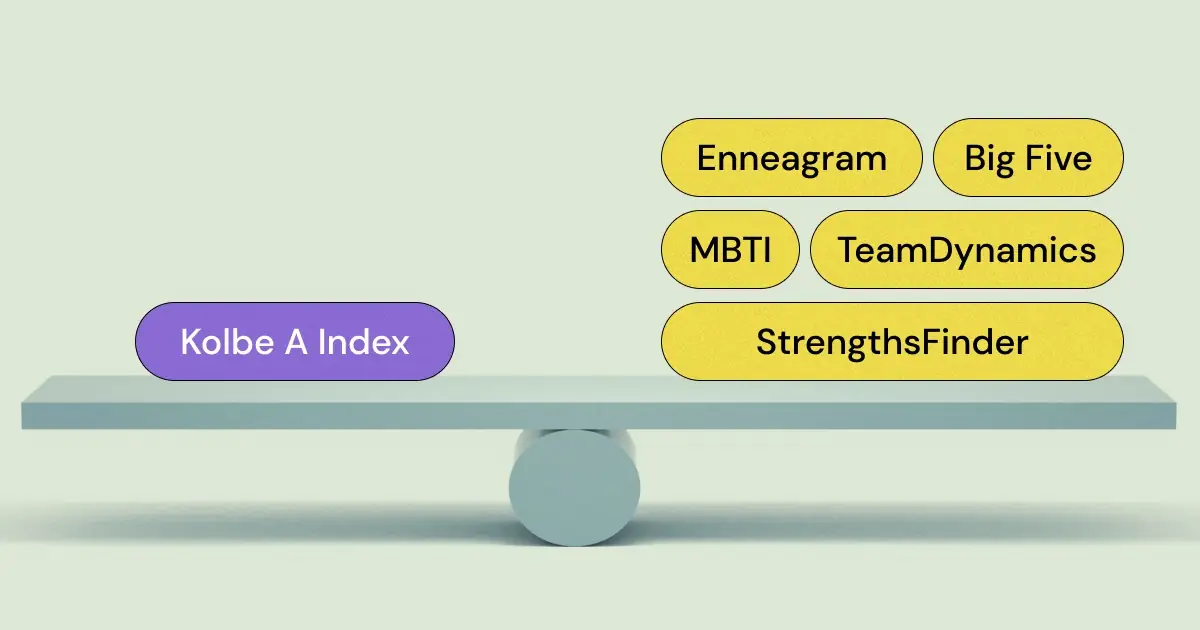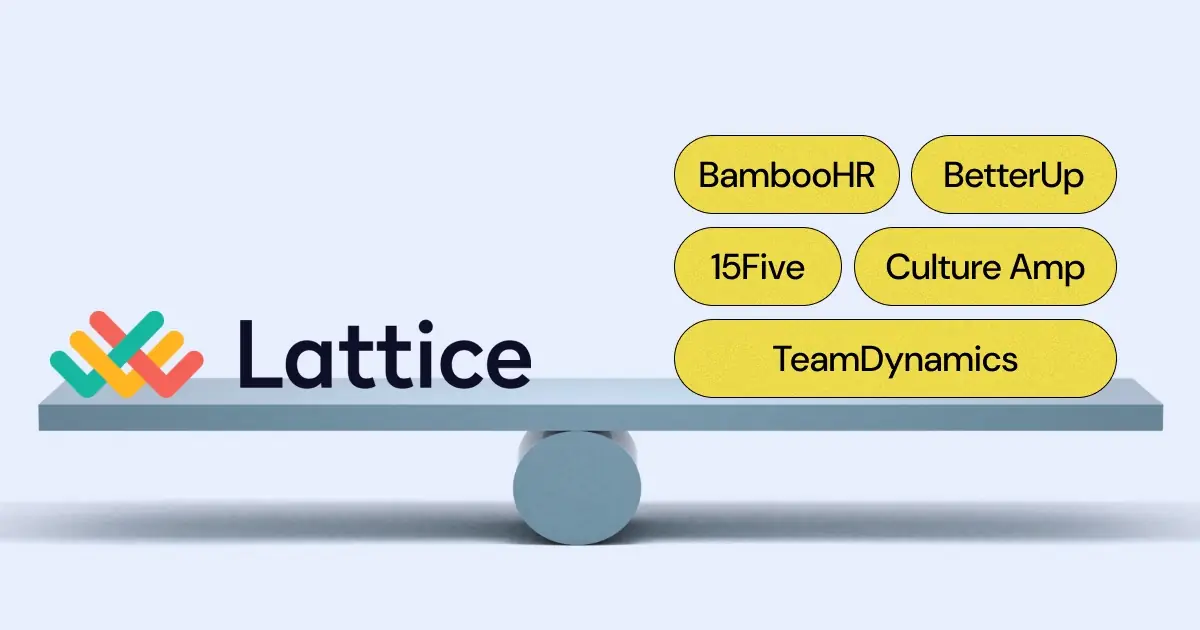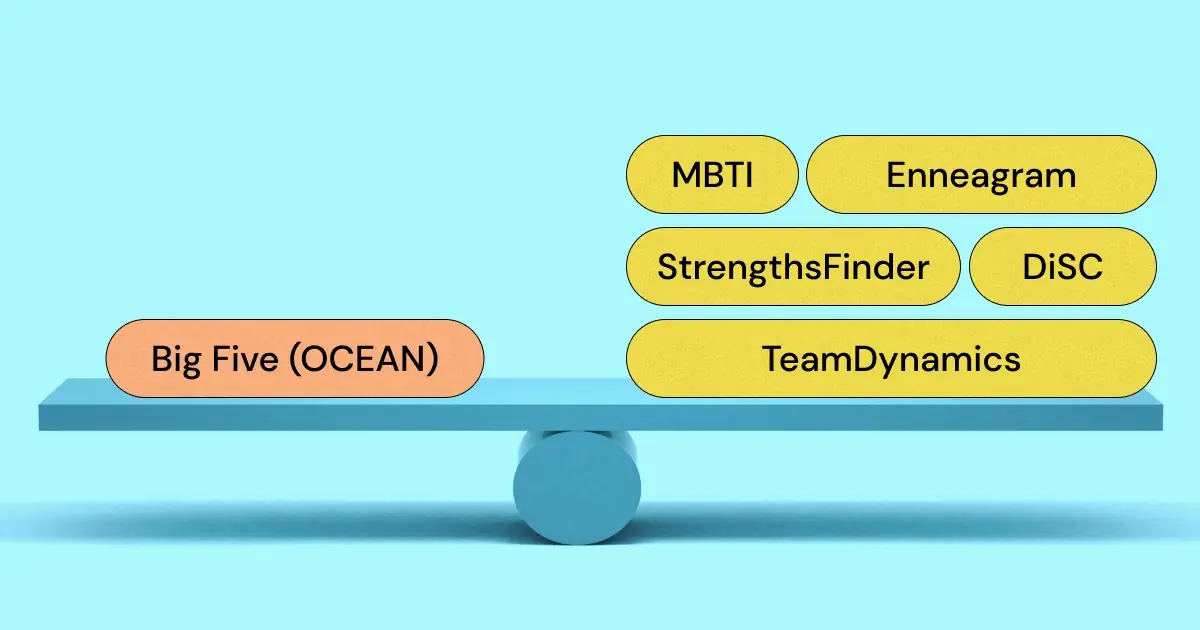The Kolbe A Index is a popular tool for understanding how people naturally take action, focusing on their instinctive strengths. While it’s a valuable resource, it might not be the perfect fit for everyone or every situation. Whether you’re looking for a different perspective on personality, deeper insights into team dynamics, or a more comprehensive assessment, there are several alternatives worth considering.
In this post, we’ll explore five of the best alternatives to the Kolbe A Index. From the scientifically-backed Big Five Personality Traits to the team-focused approach of TeamDynamics, each of these assessments offers unique benefits that can help you understand yourself and your team better. We’ll compare how these tests stack up against the Kolbe A Index, highlighting their strengths and ideal use cases so you can choose the right tool for your needs.
Let’s get into the details and find the assessment that’s best for you and your team.
Alternative #1: Big Five Personality Traits
The Big Five Personality Traits offers a more comprehensive and scientifically grounded assessment of personality compared to the Kolbe A Index. If you’re looking for a tool that provides deep insights into your personality and can predict how you’ll behave in various scenarios, the Big Five is a strong contender. Its flexibility and wide range of applications make it an excellent choice for both individual growth and team development.
The Big Five Personality Traits, also known as the Five-Factor Model, is one of the most widely recognized frameworks for understanding human personality. It breaks down personality into five core dimensions: Openness, Conscientiousness, Extraversion, Agreeableness, and Neuroticism (often abbreviated as OCEAN). Each of these traits represents a spectrum, allowing for a nuanced understanding of individual differences.
Key Features of Big Five
- Comprehensive Analysis: The Big Five provides a broad view of personality, covering various aspects of human behavior and thought processes.
- Scientific Foundation: Backed by extensive research and widely accepted in psychology, the Big Five offers a reliable and valid assessment of personality.
- Flexibility: It can be used in various contexts, from personal development to workplace dynamics, making it a versatile tool for both individuals and teams.
What Makes Big Five Special
What sets the Big Five apart is its emphasis on understanding personality as a continuum rather than categorizing people into fixed types. This approach allows for more nuanced insights into how individuals behave across different situations. It’s also highly adaptable, with applications in various fields such as psychology, education, and human resources. The Big Five’s empirical basis ensures that the results are not only descriptive but also predictive of behavior.
Practical Applications of Big Five
The Big Five is particularly useful in areas such as recruitment, career counseling, and personal development. Employers often use it to assess how well candidates might fit into a company’s culture or specific roles. In education, it helps in understanding students’ learning styles and potential challenges. For personal growth, the Big Five can provide insights into areas where an individual might want to focus on improving, such as building resilience or enhancing creativity.
Want to use Big Five Personality Traits for team building? Check out our Big Five team building tool!
Big Five vs. Kolbe A Index
When comparing the Big Five to the Kolbe A Index, several key differences stand out:
- Scope of Assessment: The Kolbe A Index focuses on how individuals instinctively approach tasks and solve problems, emphasizing action modes. In contrast, the Big Five offers a broader perspective by assessing underlying personality traits that influence behavior in a variety of contexts.
- Scientific Backing: While the Kolbe A Index is valued for its practical insights, the Big Five has a stronger foundation in scientific research, making it a more reliable tool for those who prioritize empirical evidence.
- Predictive Power: The Big Five’s ability to predict behavior in different situations gives it an edge over Kolbe A, especially in long-term planning and development strategies.
Alternative #2: TeamDynamics
TeamDynamics stands out as an ideal tool for organizations that prioritize teamwork and collective performance. Its unique focus on the entire team’s behaviors and natural biases provides a level of insight that the Kolbe A Index, with its emphasis on individual action modes, simply cannot match. If your goal is to build a stronger, more cohesive team, or if you want to understand how individual preferences influence team dynamics, TeamDynamics offers a more comprehensive and practical solution. For professional environments where collaboration is key, TeamDynamics is a better choice than the Kolbe A Index.
TeamDynamics is a personality assessment tool specifically designed to analyze the dynamics within a team. Unlike traditional personality tests that focus solely on individual traits, TeamDynamics looks at the collective behavior of the entire team, assessing core behaviors, natural biases, and how individual preferences align with or differ from the group’s tendencies. This makes it particularly valuable in professional environments where collaboration and team cohesion are critical.
Key Features of TeamDynamics
- Team-Centric Approach: Unlike most personality assessments, TeamDynamics is designed to evaluate the whole team rather than just the individual, making it highly effective for improving team performance.
- Behavioral Insights: The assessment focuses on core behaviors and natural biases within the team, offering actionable insights into how the team operates.
- Alignment Analysis: TeamDynamics examines how each team member’s preferences align with or deviate from the overall team dynamic, providing a roadmap for enhancing collaboration and productivity.
What Makes TeamDynamics Special
What sets TeamDynamics apart is its holistic approach to personality assessment. Instead of treating each team member’s personality as an isolated factor, it considers the interplay between individual preferences and the team’s collective behavior. This focus on group dynamics makes it an ideal tool for building stronger, more cohesive teams. By identifying potential areas of conflict or synergy, TeamDynamics helps teams work more effectively together, ultimately leading to better outcomes in a professional setting.
Want to see what TeamDynamics offers? Download a preview of TeamDynamics today!
Practical Applications of TeamDynamics
TeamDynamics shines in environments where teamwork is essential. It’s particularly useful for managers looking to optimize team performance, enhance communication, and reduce friction among team members. In corporate settings, it can be used during team-building exercises, restructuring efforts, or when integrating new members into an existing team. The insights provided by TeamDynamics can also be valuable in leadership development programs, helping leaders understand how to best manage and motivate their teams.
TeamDynamics vs. Kolbe A Index
When comparing TeamDynamics to the Kolbe A Index, several important distinctions emerge:
- Focus on Team vs. Individual: While the Kolbe A Index is centered on understanding an individual’s instinctive strengths and how they approach tasks, TeamDynamics broadens the scope by analyzing the entire team’s dynamics. This makes TeamDynamics more effective in situations where teamwork and collaboration are key.
- Actionable Team Insights: TeamDynamics goes beyond assessing individual behaviors by providing insights into how these behaviors interact within a team. The Kolbe A Index, on the other hand, focuses more on individual problem-solving styles, which might not always translate into effective team collaboration.
- Bias and Alignment Analysis: TeamDynamics’ ability to identify natural biases within a team and how individual preferences align with the team’s behaviors offers a unique advantage. This is particularly valuable for teams looking to improve their overall efficiency and cohesion, something the Kolbe A Index does not specifically address.
{{inline-cta}}
Alternative #3: Enneagram
The Enneagram offers a unique approach to personality assessment by focusing on core motivations and emotional drivers. If you’re looking for a tool that provides deep insights into why you or your team members act the way they do, and offers guidance on personal growth, the Enneagram is an excellent choice. Its dynamic nature and emphasis on personal development make it more suited for those who want to explore their emotional landscape and evolve over time.
The Enneagram is a personality assessment tool that categorizes individuals into one of nine distinct personality types, each representing a different core motivation and worldview. Unlike many other personality tests, the Enneagram goes deep into the emotional drivers behind behavior, providing insights into why people think and act the way they do. It’s a popular tool for personal growth, helping individuals understand their underlying motivations and areas for development.
Key Features of Enneagram
- Nine Personality Types: The Enneagram identifies nine distinct personality types, each with its own set of motivations, fears, and growth paths.
- Focus on Core Motivations: Unlike assessments that focus on behavior or cognition, the Enneagram emphasizes understanding the deeper emotional drivers behind actions.
- Growth-Oriented: The Enneagram not only identifies your type but also provides guidance on how to move toward personal growth and development.
- Dynamic System: The Enneagram recognizes that people can change and grow over time, offering a more fluid understanding of personality compared to static models.
What Makes Enneagram Special
The Enneagram’s unique focus on core motivations and emotional drivers sets it apart from other personality assessments. While many tests categorize behavior or cognitive approaches, the Enneagram digs deeper into why people act the way they do. This depth of insight makes it especially valuable for those interested in personal development and self-awareness. Additionally, the Enneagram is dynamic, acknowledging that people can grow and evolve, which allows for a more personalized and developmental approach to understanding oneself.
Practical Applications of Enneagram
The Enneagram is widely used in both personal and professional settings. On a personal level, it helps individuals identify their core fears and desires, providing a roadmap for personal growth. In the workplace, the Enneagram can be used to improve team dynamics by helping colleagues understand each other’s motivations and communication styles. It’s also valuable for leadership development, offering insights into how different personality types can be effectively managed and motivated.
Want to use the Enneagram for team building? Check out our free Enneagram team building download!
Enneagram vs. Kolbe A Index
When comparing the Enneagram to the Kolbe A Index, several key differences stand out:
- Emotional Depth vs. Cognitive Focus: The Kolbe A Index primarily focuses on how individuals instinctively approach tasks and solve problems, emphasizing cognitive and action-oriented aspects. In contrast, the Enneagram explores the emotional motivations behind behavior, offering a deeper understanding of why individuals act as they do.
- Personal Growth Orientation: While the Kolbe A Index provides insights into natural strengths and how to leverage them, the Enneagram goes a step further by offering guidance on personal growth. This makes it a more holistic tool for those seeking not just to understand their behavior, but to evolve and develop.
- Dynamic vs. Static: The Enneagram’s recognition of personal growth and change over time makes it a more dynamic tool compared to the more static approach of the Kolbe A Index, which focuses on fixed action modes.
Alternative #4: StrengthsFinder (Gallup CliftonStrengths)
StrengthsFinder offers a focused, strengths-based approach that is ideal for individuals and teams looking to enhance their performance by leveraging natural talents. Its emphasis on actionable insights and positive psychology makes it a more practical tool for those seeking immediate, real-world applications of their strengths. While the Kolbe A Index provides valuable insights into cognitive and instinctive approaches, StrengthsFinder’s clear, actionable guidance on how to excel in specific areas makes it a superior choice for professional development and team building. If you’re looking to maximize your potential and create a more strengths-oriented environment, StrengthsFinder is the better option.
StrengthsFinder, now known as CliftonStrengths, is a popular assessment tool designed to help individuals identify their top strengths. Developed by Gallup, it focuses on positive psychology and highlights 34 different strengths, ranking them to show individuals where they naturally excel. Unlike many other personality tests that focus on a broad range of traits, StrengthsFinder zeroes in on what you do best, providing actionable insights that can be immediately applied to personal and professional growth.
Key Features of StrengthsFinder
- Strengths-Based Approach: StrengthsFinder identifies an individual’s top strengths out of 34 possible themes, encouraging people to focus on and develop these strengths.
- Actionable Insights: The assessment provides practical advice on how to leverage your strengths in your career, relationships, and personal development.
- Positive Psychology: StrengthsFinder is rooted in positive psychology, emphasizing what people do well rather than focusing on weaknesses.
- Widely Used in Professional Development: The tool is frequently used by organizations to improve employee engagement, leadership, and team dynamics.
What Makes StrengthsFinder Special
StrengthsFinder is unique in its laser focus on strengths rather than a broad analysis of personality traits. This strengths-based approach encourages individuals to develop their natural talents, which can lead to increased job satisfaction and performance. The assessment’s practical focus on applying strengths in real-world scenarios makes it particularly valuable for professionals looking to enhance their careers. Moreover, its widespread adoption in the corporate world underscores its effectiveness in improving workplace outcomes.
Want to use StrengthsFinder for team building? Check out our free CliftonStrengths team building workshop download!
Practical Applications of StrengthsFinder
StrengthsFinder is highly applicable in various professional settings, especially in career development and team building. It’s often used by managers to better understand their employees’ strengths and how to leverage them for team success. For individuals, it offers a clear pathway to personal development by focusing on what they naturally excel at, leading to more fulfilling and successful careers. In team environments, StrengthsFinder helps create a culture of recognition and appreciation, where each member’s contributions are valued and maximized.
StrengthsFinder vs. Kolbe A Index
When comparing StrengthsFinder to the Kolbe A Index, several notable differences emerge:
- Focus on Strengths vs. Cognitive Modes: The Kolbe A Index assesses how individuals instinctively approach tasks and problem-solving, focusing on cognitive styles. StrengthsFinder, on the other hand, emphasizes identifying and developing individual strengths, making it more practical for those looking to enhance specific skills and abilities.
- Practical Application: StrengthsFinder provides actionable insights that can be immediately applied in the workplace, making it highly practical for career development and team building. While the Kolbe A Index is useful for understanding how individuals take action, StrengthsFinder offers more direct guidance on how to succeed by leveraging natural talents.
- Positive Psychology: StrengthsFinder’s foundation in positive psychology sets it apart from the Kolbe A Index, which is more focused on understanding instinctive behaviors. This strengths-based approach aligns with the growing emphasis on well-being and positive development in both personal and professional contexts.
Alternative #5: MBTI (Myers-Briggs Type Indicator)
MBTI offers a well-rounded and widely recognized approach to personality assessment, making it a versatile tool for both personal and professional development. Its emphasis on understanding natural preferences and how these influence behavior in different contexts makes it an excellent choice for those seeking to enhance self-awareness, improve communication, and build stronger teams. While the Kolbe A Index provides valuable insights into cognitive approaches to tasks, MBTI’s comprehensive personality typology and its widespread application make it a superior choice for those looking for a more holistic understanding of themselves and their interactions with others. If you want a tool that offers both depth and breadth in personality assessment, MBTI is the better option.
The Myers-Briggs Type Indicator (MBTI) is one of the most well-known personality assessments in the world. It categorizes individuals into 16 distinct personality types based on four dichotomies: Extraversion vs. Introversion, Sensing vs. Intuition, Thinking vs. Feeling, and Judging vs. Perceiving. Each person’s type is represented by a four-letter code (e.g., INTJ, ENFP), which provides insights into their preferences, strengths, and potential areas for growth.
Key Features of MBTI
- 16 Personality Types: MBTI categorizes individuals into one of 16 distinct types, each with its own unique characteristics and behavioral tendencies.
- Focus on Preferences: The assessment explores natural preferences in how people perceive the world and make decisions, offering insights into personal and professional behavior.
- Widely Recognized: MBTI is extensively used in both personal and professional contexts, particularly in career counseling, team building, and leadership development.
- Type Dynamics: Beyond the four dichotomies, MBTI also explores how these preferences interact within an individual, providing a deeper understanding of their personality.
What Makes MBTI Special
MBTI’s widespread recognition and ease of understanding make it a powerful tool for personal and professional development. It provides a structured way to explore personality, helping people understand their natural preferences and how these influence their behavior in various situations. MBTI is particularly valuable in enhancing self-awareness and improving interpersonal relationships, making it a staple in many organizational settings. Additionally, the detailed descriptions of each personality type offer actionable insights that can be applied to both personal growth and team dynamics.
Practical Applications of MBTI
MBTI is widely used in career development, helping individuals find roles that align with their natural preferences. In team settings, it is used to improve communication, collaboration, and conflict resolution by helping team members understand and appreciate each other’s differences. MBTI is also a valuable tool in leadership development, offering insights into how different personality types can be managed and motivated effectively. The assessment’s flexibility allows it to be applied in a variety of contexts, from personal growth to organizational development.
Want to use MBTI for team building? Check out our free MBTI team building workshop download!
MBTI vs. Kolbe A Index
When comparing MBTI to the Kolbe A Index, several key differences are evident:
- Personality Typology vs. Cognitive Focus: MBTI categorizes individuals into personality types based on preferences, providing a broad understanding of how they perceive the world and make decisions. In contrast, the Kolbe A Index focuses on cognitive styles and how people instinctively approach tasks. MBTI’s broader approach offers a more comprehensive view of personality.
- Interpersonal Insights: MBTI’s focus on how people interact with the world and others makes it particularly useful for improving communication and teamwork. The Kolbe A Index, while valuable for understanding action modes, doesn’t delve as deeply into interpersonal dynamics.
- Widespread Application: MBTI’s extensive use in professional settings, particularly in career counseling and team building, highlights its practicality. The Kolbe A Index, while useful, is more niche in its application, focusing on specific cognitive styles rather than offering a comprehensive personality assessment.
Comparing the Top 5 Alternatives to Kolbe A Index
So which of these leading alternatives to the Kolbe A Index personality test is right for you and your goals? Take a look at this comparison table to find out!
| Tool |
Primary Focus |
Best For |
Key Features |
| Big Five Personality Traits |
Research-Based Personality Traits |
Providing a scientific and comprehensive personality analysis for predicting behavior |
Assesses five core traits (Openness, Conscientiousness, Extraversion, Agreeableness, Neuroticism); known for strong predictive power and scientific validity. |
| TeamDynamics |
Team Collaboration and Cohesion |
Enhancing team dynamics and productivity by focusing on collective team behaviors |
Analyzes individual preferences in a team context; provides insights into collaboration, potential friction points, and overall team alignment. |
| Enneagram |
Core Motivations and Emotional Drivers |
Building self-awareness and empathy through a deeper understanding of motivations |
Nine personality types focusing on motivations, fears, and growth; ideal for personal development and improving interpersonal relationships. |
| StrengthsFinder (CliftonStrengths) |
Strength-Based Development |
Creating a strengths-oriented culture for improved individual and team performance |
Highlights top strengths out of 34 possible themes; focuses on actionable insights and positive psychology. |
| MBTI (Myers-Briggs Type Indicator) |
Cognitive Styles and Decision-Making |
Understanding cognitive preferences to improve communication and teamwork |
16 personality types based on four dichotomies; widely used for self-awareness, team-building, and career counseling. |
Conclusion
Choosing the right personality assessment can make a significant difference in both personal development and team dynamics. The Kolbe A Index offers valuable insights into how individuals instinctively approach tasks and solve problems, making it a useful tool for understanding cognitive styles. However, when it comes to building a higher-performing team and fostering a thriving workplace environment, other assessments might offer a better fit.
The Big Five Personality Traits provides a comprehensive and scientifically-backed analysis of personality, helping to predict behavior in various situations. StrengthsFinder focuses on identifying and developing individual strengths, offering actionable insights for career growth and team building. The Enneagram digs deep into core motivations and emotional drivers, providing a path for personal growth. And MBTI, with its well-known personality typology, offers a broad understanding of how people perceive the world and interact with others.
Among these options, TeamDynamics stands out as the ideal choice for most workplace settings. Unlike other assessments, which focus primarily on the individual, TeamDynamics takes a holistic approach by evaluating the entire team. It looks at core behaviors, natural biases, and how individual preferences align with the team’s dynamics. This unique focus on team performance and collaboration makes it an invaluable tool for managers and leaders who want to build cohesive, high-performing teams.
In the fast-paced and interconnected world of modern work, understanding how your team operates as a unit is crucial. TeamDynamics not only helps you identify the strengths and challenges within your team but also provides actionable insights to improve communication, reduce friction, and align efforts toward common goals. If your priority is to create a stronger, more collaborative, and more productive team, TeamDynamics is likely the best choice for your organization. Try TeamDynamics today and see how it can unlock your team’s full potential.




.png)











































